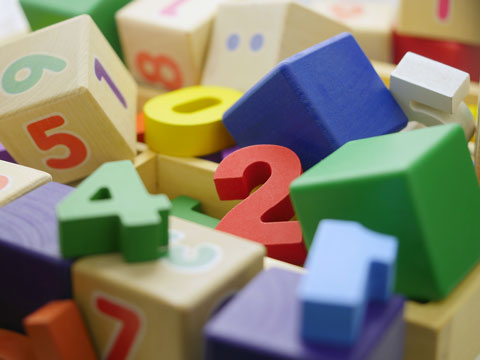Many 4-and 5-year-olds know that anything they count needs a “number name” (one car, two cars) and that numbers have a set order (1-2-3-4). They know that quantities change when they add or remove items. They often enjoy playing with number concepts. Here are some ways to help older preschool children learn more about numbers. (See Illinois Early Learning and Development Benchmarks 6.A.ECd, 6.B.ECb, 6.B.ECd, and 6.D.ECa.)

Use the language of numbers.
- Explain and use words like numeral, zero, skip-counting, countdown, pair, whole/part, many/few, half, subtract.
- Help children ask and answer thought-provoking number questions: “We have 6 crackers and 3 children. How many can each of you have so it’s fair?” “Is it always best to have more of something instead of less?”
Make numbers part of the daily routine.
- Help the class keep track of the days of school. They can take turns marking on a number line or putting a row of index cards up around the room, one for each day. Ask them to predict how long the row will be on the 100 th day of class.
- Ask children to figure out how many cups and napkins to set out for snack.
- Let children vote on classroom issues with more than two options. “Six people want to sing ‘BINGO’; 2 want ‘Mary Mack’; and 3 don’t want to sing at all!”
Provide games that involve numbers and counting.
- Teach games such as lotto, bingo, dreidel, Hi-Ho-Cherrio, Pyramid Solitaire, Double (Addition) War.
- Simplify Yahtzee, Sorry, Uno, or Monopoly Junior for young players.
- Help small groups plan scavenger hunts: “Find 4 shiny rocks, 10 dandelions, and 5 acorns.”
Bring numbers into investigations and project work.
- Help children create simple survey forms for polling classmates or families: “What color are your eyes?” “How many seeds are in your apple?”
- Encourage children to separate a large group of items (such as pumpkin seeds) into sets of 10, then skip-count by 10s.
Offer other activities that promote working with numbers.
- Encourage children to solve addition and subtraction word problems using blocks, integer rods, plastic animals, coins, etc.
- Share books that involve numbers, counting, parts, and wholes.
- Invite children to create their own games that use spinners or dice.


 Printer-friendly PDF
Printer-friendly PDF PDF para imprimir
PDF para imprimir